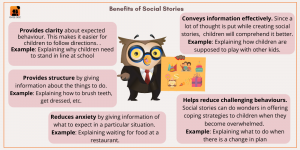Social stories are simple narratives that help people having deficits in social pragmatics understand appropriate social interaction protocols and responses. While they were originally developed for children on the spectrum, they can be useful for people of all ages having social communication challenges. Visual representation of a situation or concept as depicted in social stories can be more meaningful to people with auditory processing issues than verbal instructions. Moreover, social stories help in reinforcing concepts by repeating the information consistently.
Using social stories is an evidence-based practice created in 1991 by Carol Gray, a teacher for children with autism. They are essentially visual descriptions of a situation, event, concept, or activity. The purpose of the story is to help children understand the situation better and to teach them socially appropriate responses.
How to write social stories?
A poorly made social story can convey wrong information to a child. So, it’s necessary to put some thought into what the story is about. Here are few things to keep in mind while writing a social story.
1.Use Simple Language
Make sure that the language is uncomplicated and does not leave much to interpretation. Typically, social stories are written from the perspective of the person for whom you’re creating the story. You can also use third person language for some older kids.
- Keep it to the Point
You may want to convey a lot of information but all that cannot be cramped into one social story. If you have different events or concepts that you need to address, create individual stories for them.
- Collect All Relevant Information
Before you start writing a story, be clear about the purpose of the story. If it’s about a particular event, try and think of all the details you have about that event. For example, if you want to write a story about an upcoming birthday party, look at how the learner had reacted to such events in the past. Was there anything particular that made them uncomfortable? Was there anything that they thoroughly enjoyed? Getting all the details written down helps you build an effective story.
- Make it Visual
Use a lot of pictures and include personal pictures if possible. For example, if you are writing a story about how to organize their things in the classroom, use pictures of their desk, materials, bins where their things should be placed, etc. This can help them make the connection to the things the story is referring to.
Benefits of Using Social Stories
Children with autism and other developmental disabilities may have processing delays and may struggle with generalization of a concept. Their sensory issues or communication deficits may also lead to challenging behaviors. Verbal instructions may not be effective and therefore social stories are seen as an excellent means to give directions to children and for behavioral regulation.


Creating Social Stories Using Avaz AAC
You can use Avaz AAC to create social stories in no time. With Avaz AAC, you can bing search for images from within the app. This means that you need not search for images on the web and import it into the app. You can also add multiple words/phrases at a go. A main advantage of making stories with Avaz AAC is that there is auditory feedback as the learner taps on the icons of the AAC system. Screen recording of the social story gives you a video which you can play for the learner when needed.
Here is a sample story made with Avaz AAC.
You can find more COVID related social stories here.
Download a free editable social story for Learning from Home here.
Get the Word file and personalize it as you wish 😊
